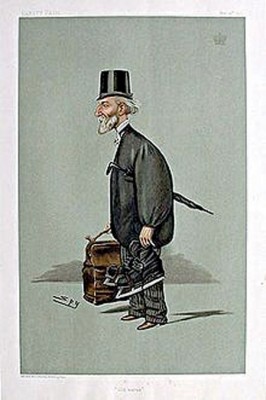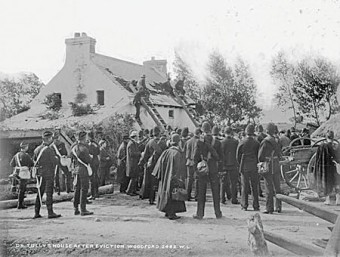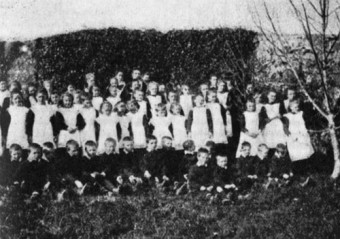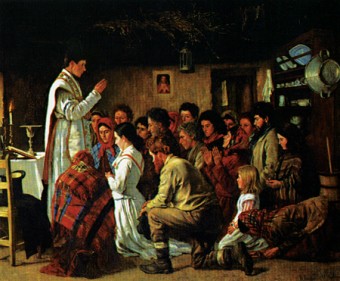Search Results for 'Miriam Moffitt'
13 results found.
Extraordinary victory for the people of east Galway

Between 1869 and 1909 a revolution took place in land ownership in Ireland. A succession of Land Acts gradually reduced the powers of the landlord, and gave their former tenants the means and the opportunity to buy out their tenancy, and to own their own farms. Generous terms were given to tenants by the Wyndham Act of 1903. £100 million was advanced for land purchase, which was immediately availed of by the great majority of tenants. Tenants were advanced the whole purchase price of their holding, at a little over three per cent to be repaid over 68 years. Most landlords were pleased to accept the ready cash, and a whole new social structure emerged throughout the island. However, initially landlords were not compelled to sell, and the independently wealthy marquis of Clanricarde of east Galway refused to cooperate. But his days of evictions, disparaging remarks about his tenants, his bully boy land agent Edward Shaw Tener and his henchmen, were numbered.
Fear and loathing in east Galway

Following the extensive publicity and extraordinary use of more than 700 military, police, emergency men and bailiffs, to evict five families from the marquis of Clanricarde’s estate, the people of Woodford and all of east Galway were in a state of shock, anger and fear. It was now clear that Clanricarde would use every method within his considerable powers to evict any of his tenants who refused to pay their rent. Despite pleas for a rent reduction because of successive bad weather, he refused to even consider it. He scoffed at John Dillon’s Plan of Campaign, supported by the Land League, which urged tenants to stick together, and to refuse to pay unreasonable rent.
A tribal book hamper for Christmas
THE NUMBER of books produced by Galway publishers or written by Galway authors over the last number of months has been as prolific as it has been varied and allows the Galway reading public the ideal opportunity to support local presses and writers, thus celebrating the scribes of their native city.
Public talk on the Protestant missions to Connemara
For nearly a century the Protestant denominations in Ireland set up missions in Connemara. Many were about winning converts, but others sought to help the communities they encountered.
The Garra Glas in the Claddagh
The Garra Glas (The green field or green garden) was an area of the Claddagh which corresponds to where the Fire Station is today. Our photograph was taken in the 1930s when things were changing in the area .. the old Claddagh houses were being gradually knocked down to make way for those that are there today. Kerbstones were being laid down to frame the newly laid road surface. The house we see on the left belonged to the Flaherty family. The building next to it was obviously converted from a cottage into a workshop of some kind with the large beam supporting the double doors. Next door was Cubbards. You can see someone peeping out the door.
Celebrate the landscape and its trees at Coole
Coole Park will host a number of events this weekend as part of its celebration of Tree Week.
Coole Park prepares for Tree Week
A range of events for all ages will take place in Coole next month as the park celebrates Tree Week as part of its spring cultural programme.
Fr Rhatigan strikes a blow for Rome
On February 28 1879 a desperate row erupted on peaceful Omey Island, near Cleggan, Connemara. The local curate Fr William Rhatigan burst into the local Protestant schoolhouse, run by the Irish Church Mission Society, saying he was ‘in search of his straying sheep’*. An argument broke out between him and the Rev William Lindsey MacNeice, the schoolmaster. Blows were struck. Who struck the first blow will forever be in dispute. But the evidence of Fr Rhatigan’s temper and strength is testified by the fact that it took the combined efforts of MacNeice, aided by his wife, his daughter Charlotte, his young son John Frederick, and two teachers from Claddaghduff, Messrs Davis and Coursey, to force him backwards out of the schoolhouse.
An unseemly brawl over God and scripture

In a week when The Irish Times reports an unseemly brawl between Armenian and Greek Orthodox monks who physically battled over turf and influence in the Church of the Holy Sepulchre in Jerusalem, revered as the site of Jesus’ crucifixion, I was reminded of the unfortunate battle for the souls of Catholics in the aftermath of the Great Famine. This episode in Connemara’s long history still engenders passionate feelings today. The expression ‘they took the soup’ is still very much alive. At the time the campaign for souls splintered communities, and divided families. In a new book Soupers and Jumpers* Miriam Moffitt reminds us that Catholics and Protestants were convinced that their religion - and only theirs - was the ‘one true faith,’ and that anyone who lived, or more importantly died, outside their particular belief system could not enter heaven. From the middle of the 19th century, the poor of Connemara and the Dublin slums were targeted by the well intentioned Anglican Irish Church Missions.
The sad leaving of Mary Mally (Malley?)

The anger and violence that erupted against the Protestant Irish Church Missions and their schools and orphanages in western Connemara towards the end of the 19th century, makes for harrowing reading today.

